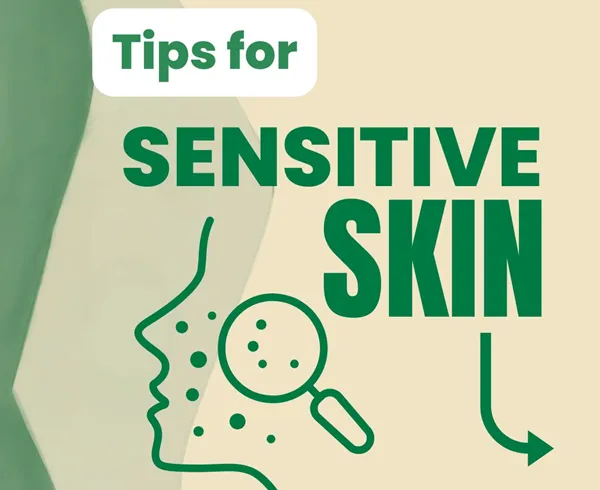
How to know if you have sensitive skin
Learn how to determine when you have a skin sensitivity through our founder's experiences and process.
As a sensitive skin sufferer my entire life, there is so much I have learned over my own failures in trying to care for my skin. I want to share those with you and hope they will help anyone learning about what it means to have sensitive skin. I am a fellow sensitive skin sufferer and not a medical professional so I applied my knowledge of the scientific method to figure out my own sensitive skin triggers.
Start by recognizing if you have sensitive skin.
I learned at a young age that I had allergies to ingredients, thanks in part to my mother's persistence. It began as a daily occurrence of hives on my back, shoulders, and legs after playing outside all day. You might first think it was grass or a plant I brushed against, but the hives were under my clothing. We decided to begin the process of "elimination" of products that would be touching my skin daily. After a few weeks, we were able to determine that the shampoo, Pert Plus, was causing my skin to react with hives. When washing my (very) long hair, the residue of the shampoo would stay on my skin. Either the dyes and/or fragrances in the shampoo were causing the issue, so we stopped using it immediately, and my reactions stopped.
Now hives are more obvious and an immediate reaction, but there are others to look for that can often be overlooked because they take time to develop. Sometimes, sensitive skin will have a reaction that builds over time and manifests in other ways that are not hives. Here are some examples:
dry patches, small or large
scaly skin
small bumps in patches of your body
acne on the body
raised bumps that are not itchy and don't go away
skin flaking or scabbing
persistent itching
skin redness
As recently as this past August, I had an example of having a skin reaction to something that wasn't a skin product. I use a shower head filter because in Puerto Rico we have very mineral heavy water. I bought a different shower head filter from a very reputable brand because the old one had broken (if you know the water pressure issues here, then you know why it broke!).
Within a day or two of using the new filter, bumps started to form on my shoulders and upper arms. My skin was no longer smooth, and some bumps were filled with white stuff but did not appear to be acne. Luckily, there was no itching, but this was not what my skin usually looked like.
Even for me, someone who is aware and monitoring what goes on my sensitive skin, I didn't connect the symptoms to the root cause right away. I kept using the filter for another 2 weeks before connected that it might be causing my skin issues. Within a week of stopping the usage of the shower filter, the bumps went away and my skin was smooth again.
To make sure the cause was the new filter, I waited two weeks before starting one more round of using the shower for a week. The bumps came back within a couple days. Before starting this second test, I double checked that I had not introduced anything new to my skin or body routine. I reduced the factors in the testing to only the shower filter.
I returned to using a cheaper filter from a "not so reputable brand" and my skin is happy again. I also made sure to call the manufacturer to let them know and request a refund with their lifetime warranty.
What will work best for anyone with sensitive skin, is to learn how to do these types of tests for reactions and monitoring what touches your skin. This first and vital step will save your skin (and sanity) so you can get control over your sensitive skin issues.
Did you know that a study from 2022 noted that over 70% of adults in self-report as having sensitive skin.1 You are not alone in this journey so I hope by sharing my own experience that your journey will be a little smoother.
There are even more things I have tried so I am sharing my top tips and tricks today so you know what works and doesn't for sensitive skin. I have been using for decades and continue to use them today.

Tips and Tricks
Keep track of what you are putting on your skin daily. From soaps, shampoos, laundry detergent, dryer sheets, lotions, deodorants, perfume, cleaning products, etc. Anything that can have contact with your skin from repeated use is logged.
Write down when you start using a new product. Track reactions from this date and when you stop using it.
Look at products that are used on items that touch your skin indirectly. Laundry detergents or cleaners used on your clothes, towels, and sheets can quickly cause skin issues.
Only introduce one new product at a time and use it for at least 3-4 weeks to determine if you have a sensitivity. If you have an immediate reaction, stop using right away.
Look for patterns in which ingredients cause a reaction and be mindful of natural ingredients. For example, I have an allergy to soy on both my skin and consuming it. I avoid any product with soy in the ingredient list because of this.
Products with added fragrances, perfumes, and dyes are known as the most common cause of skin irritation. Don't use products with these ingredients whenever you can.
Look for products with fewer ingredients and if there is fragrance or perfume, it is listed as the last ingredient.
Don't always trust products marketed as safe for sensitive skin but have dyes and or fragrances. These products aren't looking out for sensitive skin if they are using these ingredients.
Using natural and plant-based ingredients are good for chemical and additive-free but be mindful that you can still be allergic to those ingredients.






